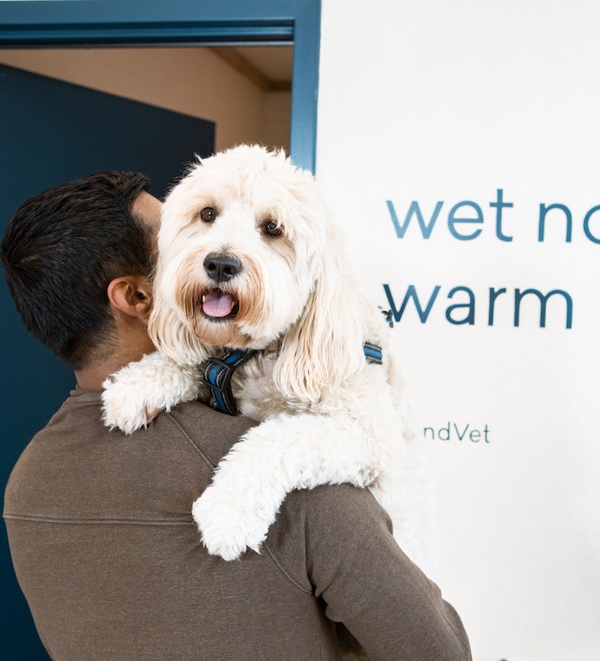
Dog Sedatives: When and How to Use Them
One of the things we love about dogs is their natural joy and playfulness. However, sometimes dogs experience fear, anxiety, and apprehension, just like humans.
Sedatives, training/behavior modification, and natural remedies are some of the tools available to help dogs with fear or stress.
Below, we’ll discuss ways to use sedatives safely and effectively in dogs…
When Do Dogs Need Sedatives?
Some pups go their whole lives without needing a sedative. Other pets suffer from long-term anxiety issues, such as separation anxiety, to the point where their safety and quality of life are greatly impacted. Many pups fall somewhere between these two extremes.
There are certain situations in which a reasonable amount of anxiety is expected, such as during a vet visit or when a new pet is adopted into the home. And some dogs experience short-term but intense anxiety during travel, grooming, toenail trims, or storms.
If a dog’s anxiety is frequent/long-term, severe, or elevated to the point where safety becomes a concern, they’d likely benefit from sedation.
How Do I Know If My Dog Is Anxious?
Some symptoms of fear, nervousness, or anxiety in dogs are obvious, while others are subtle. Some signs to watch for include:
Attempts to escape. This could mean anything from turning away at the door of the vet hospital to full-blown panic and destructive behaviors.
Ears pulled back.
Crouching or making themselves as small as possible.
Tail tucked between the legs.
“Whale eyes,” which means eyes that are open very wide. The whites of the eyes may be more prominent than usual. They also may be avoiding eye contact.
Panting.
Pacing.
Trembling.
Tense muscles.
Bathroom accidents or anal gland release.
Barking excessively.
Sometimes, growling, showing teeth, or other signs of aggression, as aggressive behaviors are often rooted in fear or anxiety in an otherwise friendly dog.
Affected dogs may show just 1-2 symptoms or several. A pup’s symptoms can help guide diagnosis and treatment. So try to observe as much as possible.
Since some of the above symptoms can also indicate a medical condition, your dog’s veterinarian may recommend diagnostic testing such as blood work prior to using a sedative. It is also recommended to ensure that vital organ function is adequate before starting long-term behavioral modification medications.
How Is Anxiety In Dogs Treated?
Behavior modification (training a dog to be less fearful and respond to stressful stimuli in healthier ways) is always indicated for dogs with anxiety.
Behavioral modification and medications often work well together. Medications allow a dog to be calm enough so that training is effective. Meanwhile, training addresses the root cause, which may allow a dog to eventually discontinue their anxiety medications (or at least use them less often or at a lower dose).
Behavior modification is crucial for separation anxiety and other long-term issues. But it can also help in short-term situations.
For example, if a pup is nervous about grooming visits, it may help to briefly stop by the groomer’s office and give the dog a treat. When this is repeated over time, a dog may grow to think of the groomer’s office as a fun place rather than a scary place. This is actually why we install treat bars at the front of each of our clinics and encourage our clinics to stop by for a treat — we want the pups to associate us with something enjoyable.
Behavior modification done properly can change a dog and pet parent’s life for the better. But, done improperly, it can reinforce anxious behaviors.
Therefore, behavior modification should always be done under the guidance of a professional — your veterinarian, a veterinary behaviorist, or a dog trainer with a lot of knowledge in experience in anxiety issues.
What Are Some Natural Remedies for Dog Anxiety?
For dogs with mild anxiety, a vet may recommend starting with these therapies prior to prescribing a sedative or anxiety medication:
Training and behavior modification, as described above.
Supplements, such as L-theanine, melatonin, Zylkene (hydrolyzed milk protein), or other calming supplements formulated for dogs.
Pheromone products (DAP or dog appeasing pheromone), which emit calming dog scent signals.
A Thundershirt or other body wrap, which can provide comfort by mimicking swaddling.
Certain probiotics, such as Purina Calming Care, have been shown to reduce certain anxieties
Always check with your vet before giving any new medication or supplement to make sure it’s safe for your pup and won’t interact with any medications they are already taking.
Which Sedatives Are Used for Dogs?
Each pup has unique needs. If a dog tranquilizer or sedative is needed, a vet will consider factors such as how severe a dog’s symptoms are, how long the anxiety has been present, a dog’s medical history, and whether a dog is taking any medications or supplements that could interact with a sedative.
Additionally, a vet will consider all the effects a medication may have on a dog:
- Some medications make a dog feel sleepy rather than relieving anxiety. These medications may help with short-term situations (such as during a yearly vet visit or for promoting rest in a dog who’s recovering from knee surgery), but might not be a good choice for a dog with severe anxiety.
- Tranquilizers are medications that have a calming or anti-anxiety effect, but don’t necessarily cause sedation or drowsiness (although some drugs may cause both).
- Some medications deliver pain relief, while others do not. Pain relief may be beneficial for older, arthritic dogs who tense their muscles when they’re nervous and therefore get sore after a car ride or grooming visit, for example.
With all this in mind, below are some of the most commonly used dog sedatives.
Benadryl
Benadryl (Diphenhydramine) is not technically a sedative. It’s an antihistamine that’s commonly used for relieving allergy symptoms. However, sedation is a very common side effect.
Benadryl is an over-the-counter medication with a good safety margin. However, it’s still important to check with your vet for the right dose and formulation (note: diphenhydramine should be the only active ingredient; don’t use Benadryl with decongestants or other combination products).
Benadryl may be a good dog sedative for car travel, as it also helps with mild car sickness.
Dry mouth or an increased heart rate are fairly common side effects. Rarely, some dogs will have an atypical response and be excitable rather than sedate.
Gabapentin
Gabapentin is a medication that can be used for several purposes, including seizure control, anxiety relief, sedation, and pain management. It’s a common dog sedative for grooming, travel, vet visits, and other short-term events.
Gabapentin is generally considered safe in healthy pets, with minimal side effects.
Trazodone
Trazodone can both sedate a dog and relieve anxiety. This is a good dog sedative for grooming, veterinary visits, thunderstorms/fireworks, and other short-term stressful events. Trazodone can take 1-2 hours to take effect and can last for about 8 hours- so it can be given multiple times during an anxiety inducing event.
Side effects include low blood pressure, so trazodone may be used cautiously or avoided in patients with certain health conditions.
Benzodiazepines (Valium, Xanax, Etc.)
These drugs help with dogs with anxiety during stressful times (thunderstorms, vet visits, grooming, travel, or fireworks), but they usually don’t have strong sedative effects.
Benzodiazepines are generally considered safe, but may be avoided in dogs with certain underlying health conditions. Additionally, in some dogs, they may cause excitement rather than calmness.
Drugs for Long-term Anxiety Issues
Some dogs, such as those with separation anxiety or severe fear of thunderstorms, may need to take daily medications for a longer period of time. Common medication categories include selective serotonin reuptake inhibitors (SSRIs) and tricyclic antidepressants. Popular options include fluoxetine, clomipramine, and amitriptyline. We generally do not recommend using SSRIs without a behavior modification training plan in place, as they are not as effective on their own.
Side effects vary, but common ones include stomach upset, heart rate changes, sedation, or excitability. These drugs must be avoided or used cautiously in dogs with certain underlying health conditions.
Injectable Sedation
For some pups, oral medication doesn’t provide enough sedation or anxiety relief. These pets may need injectable sedation administered by a veterinarian during a veterinary checkup, toenail trim, x-rays, or other procedures.
Injectable drugs at a veterinarian’s office are typically stronger than oral medications that are sent home, and thus only administered by veterinary professionals who are trained and prepared to monitor a pet to ensure their heart rate, breathing, and temperature all remain normal during sedation.
What Else Should I Know About Sedatives and Dogs?
It’s important to understand that sedating a dog often requires trial and error to find the best medication and dose, since each dog may respond to sedation differently.
Also, many sedatives can be “overridden” by stress and excitement. So even if a pup had a great response to sedation on one occasion, they may have a different response if they’re more worked up the next time.
To combat this issue, keep a sedated dog as calm as possible. Talk in a quiet and soothing voice, avoid loud noises, and provide a dark, quiet place to rest.
Below are some additional important tips for sedating a dog.
- Many vets recommend a “trial run” for short-term sedatives. For example, if using a dog sedative for car travel, give your pup a dose at home before the big travel day to make sure the medication works the way you want it to.
- Certain sedatives affect a dog’s ability to regulate their body temperature and may make accidents more likely (i.e. dogs should avoid stairs while sedated). Be sure to monitor your pup until they’re more awake, or as advised by your vet.
- Veterinarians may use a combination of two sedatives together. Often, this achieves great sedation or tranquilization while reducing the risk of side effects.
- However, some drugs are not safe to combine (in particular, more than one SSRI should not be used together), so don’t try to do combinations without your vet’s recommendation.
- Many airlines don’t allow sedatives during travel, due to safety risks. This is especially true for pets flying in cargo who can’t be monitored, and for short-nosed breeds who are more prone to respiratory distress and may have more difficulty regulating their body temperature.
As you can see, dog sedatives are not one-size-fits-all. But after consulting with a veterinarian, most pet parents can find an option that works well for keeping their pup relaxed, happy, and safe.
Could your dog benefit from sedation? Schedule a consultation with one of our caring veterinarians to learn more.
About the Author
